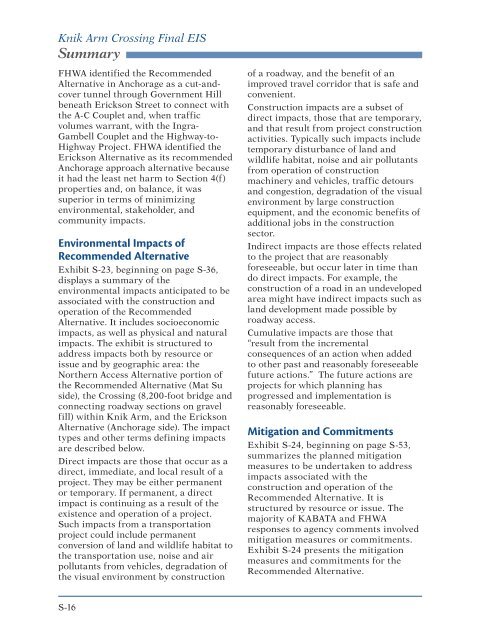FEIS Summary - Knik Arm Bridge and Toll Authority
FEIS Summary - Knik Arm Bridge and Toll Authority
FEIS Summary - Knik Arm Bridge and Toll Authority
You also want an ePaper? Increase the reach of your titles
YUMPU automatically turns print PDFs into web optimized ePapers that Google loves.
<strong>Knik</strong> <strong>Arm</strong> Crossing Final EIS<br />
<strong>Summary</strong><br />
FHWA identified the Recommended<br />
Alternative in Anchorage as a cut-<strong>and</strong>cover<br />
tunnel through Government Hill<br />
beneath Erickson Street to connect with<br />
the A-C Couplet <strong>and</strong>, when traffic<br />
volumes warrant, with the Ingra-<br />
Gambell Couplet <strong>and</strong> the Highway-to-<br />
Highway Project. FHWA identified the<br />
Erickson Alternative as its recommended<br />
Anchorage approach alternative because<br />
it had the least net harm to Section 4(f)<br />
properties <strong>and</strong>, on balance, it was<br />
superior in terms of minimizing<br />
environmental, stakeholder, <strong>and</strong><br />
community impacts.<br />
Environmental Impacts of<br />
Recommended Alternative<br />
Exhibit S-23, beginning on page S-36,<br />
displays a summary of the<br />
environmental impacts anticipated to be<br />
associated with the construction <strong>and</strong><br />
operation of the Recommended<br />
Alternative. It includes socioeconomic<br />
impacts, as well as physical <strong>and</strong> natural<br />
impacts. The exhibit is structured to<br />
address impacts both by resource or<br />
issue <strong>and</strong> by geographic area: the<br />
Northern Access Alternative portion of<br />
the Recommended Alternative (Mat Su<br />
side), the Crossing (8,200-foot bridge <strong>and</strong><br />
connecting roadway sections on gravel<br />
fill) within <strong>Knik</strong> <strong>Arm</strong>, <strong>and</strong> the Erickson<br />
Alternative (Anchorage side). The impact<br />
types <strong>and</strong> other terms defining impacts<br />
are described below.<br />
Direct impacts are those that occur as a<br />
direct, immediate, <strong>and</strong> local result of a<br />
project. They may be either permanent<br />
or temporary. If permanent, a direct<br />
impact is continuing as a result of the<br />
existence <strong>and</strong> operation of a project.<br />
Such impacts from a transportation<br />
project could include permanent<br />
conversion of l<strong>and</strong> <strong>and</strong> wildlife habitat to<br />
the transportation use, noise <strong>and</strong> air<br />
pollutants from vehicles, degradation of<br />
the visual environment by construction<br />
of a roadway, <strong>and</strong> the benefit of an<br />
improved travel corridor that is safe <strong>and</strong><br />
convenient.<br />
Construction impacts are a subset of<br />
direct impacts, those that are temporary,<br />
<strong>and</strong> that result from project construction<br />
activities. Typically such impacts include<br />
temporary disturbance of l<strong>and</strong> <strong>and</strong><br />
wildlife habitat, noise <strong>and</strong> air pollutants<br />
from operation of construction<br />
machinery <strong>and</strong> vehicles, traffic detours<br />
<strong>and</strong> congestion, degradation of the visual<br />
environment by large construction<br />
equipment, <strong>and</strong> the economic benefits of<br />
additional jobs in the construction<br />
sector.<br />
Indirect impacts are those effects related<br />
to the project that are reasonably<br />
foreseeable, but occur later in time than<br />
do direct impacts. For example, the<br />
construction of a road in an undeveloped<br />
area might have indirect impacts such as<br />
l<strong>and</strong> development made possible by<br />
roadway access.<br />
Cumulative impacts are those that<br />
“result from the incremental<br />
consequences of an action when added<br />
to other past <strong>and</strong> reasonably foreseeable<br />
future actions.” The future actions are<br />
projects for which planning has<br />
progressed <strong>and</strong> implementation is<br />
reasonably foreseeable.<br />
Mitigation <strong>and</strong> Commitments<br />
Exhibit S-24, beginning on page S-53,<br />
summarizes the planned mitigation<br />
measures to be undertaken to address<br />
impacts associated with the<br />
construction <strong>and</strong> operation of the<br />
Recommended Alternative. It is<br />
structured by resource or issue. The<br />
majority of KABATA <strong>and</strong> FHWA<br />
responses to agency comments involved<br />
mitigation measures or commitments.<br />
Exhibit S-24 presents the mitigation<br />
measures <strong>and</strong> commitments for the<br />
Recommended Alternative.<br />
S-16
















